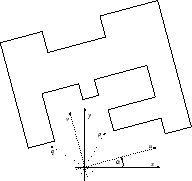A polygon ![]() is rectilinear if its interior angles belong to
is rectilinear if its interior angles belong to
![]() .
.
The Euclidean length of the straight line segment
![]() is
is
![]() , while the
length of
, while the
length of ![]() according to the
according to the ![]() metric is
metric is
![]() .
.
![]() will denote the Euclidean perimeter of
will denote the Euclidean perimeter of ![]() , while
, while
![]() will denote the perimeter of
will denote the perimeter of ![]() in the sense of
in the sense of ![]() metrics.
metrics.
Since isometric polygons do not necessarily have the same
perimeter under the ![]() metric, we shall use
metric, we shall use
![]() for the
for the ![]() perimeter of the polygon which is
obtained by the rotating
perimeter of the polygon which is
obtained by the rotating ![]() by the angle
by the angle ![]() with the origin
as the centre of rotation.
with the origin
as the centre of rotation.
 |
Theorem 1.
A given polygon ![]() is rectilinear if and only if there exists a choice
of the coordinate system
such that the Euclidean perimeter of
is rectilinear if and only if there exists a choice
of the coordinate system
such that the Euclidean perimeter of ![]() and the
and the ![]() perimeter of
perimeter of ![]() coincide, i.e.,
coincide, i.e.,